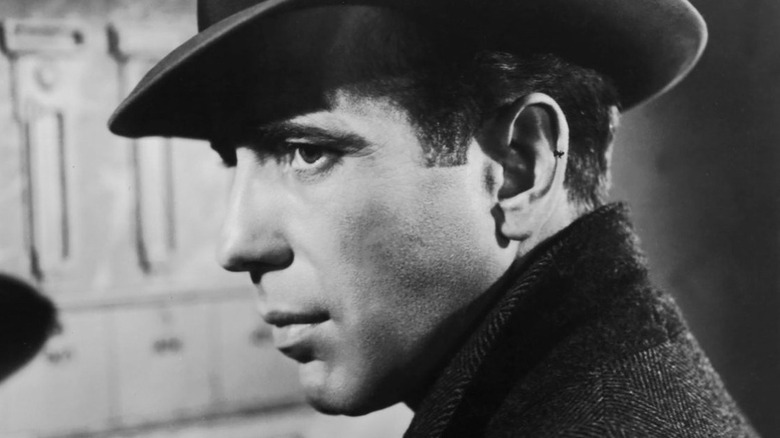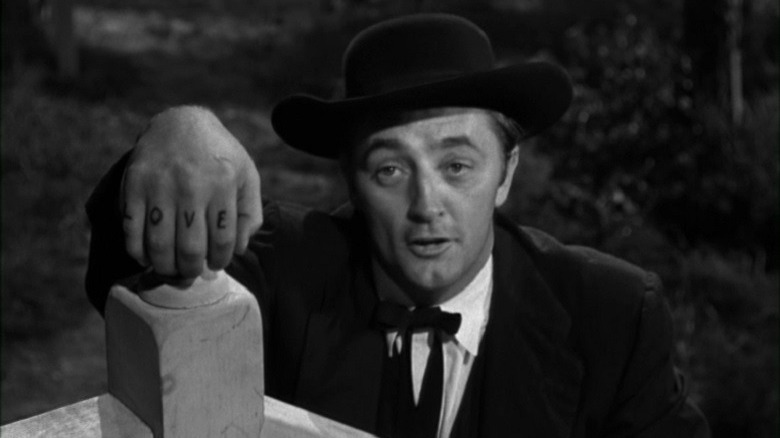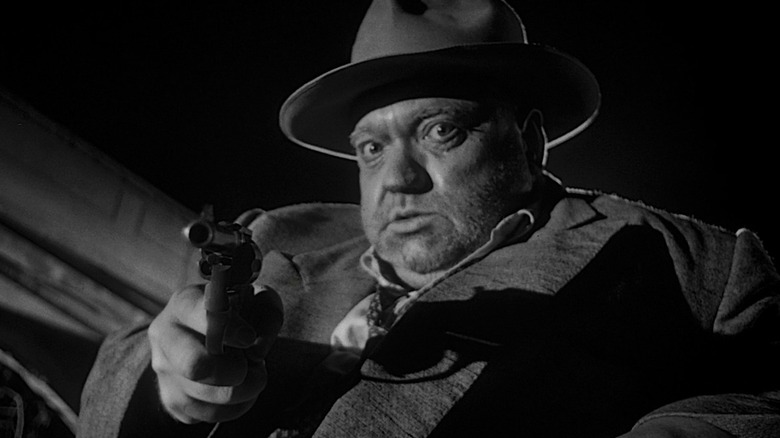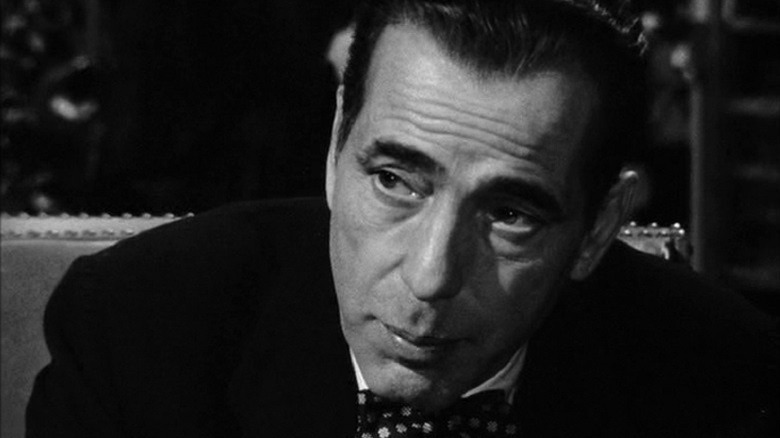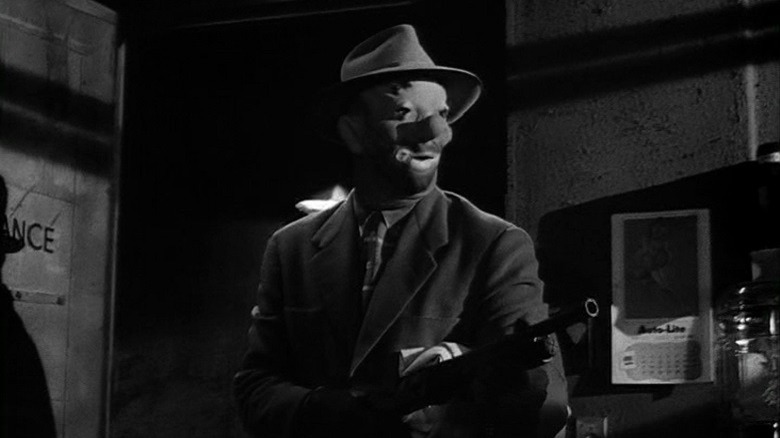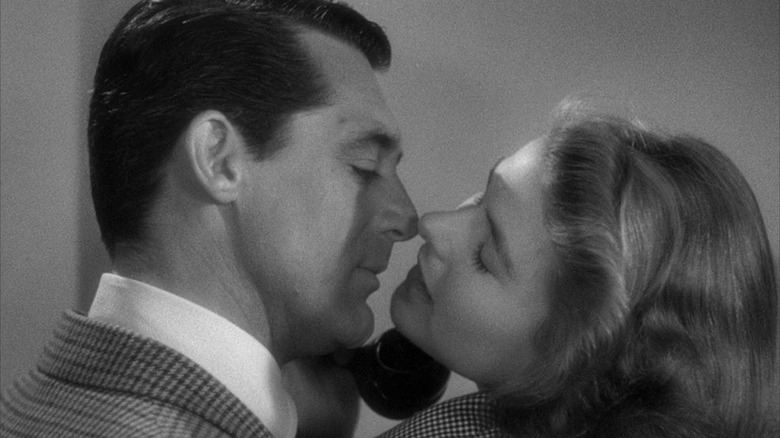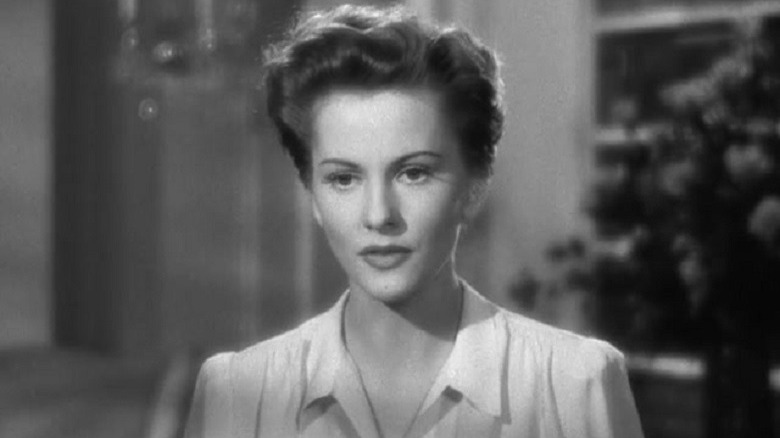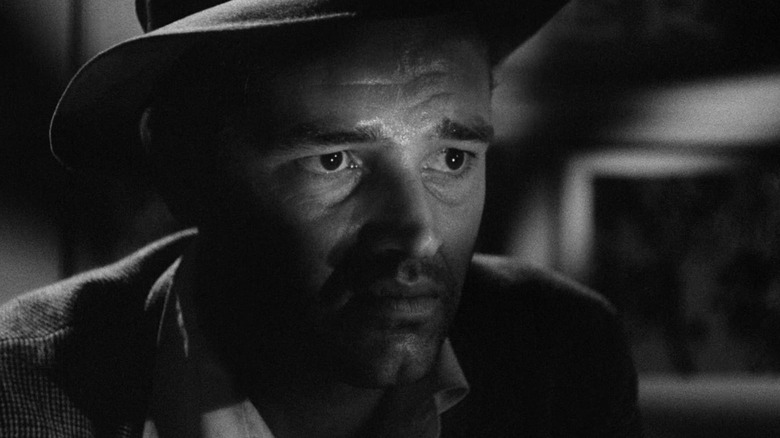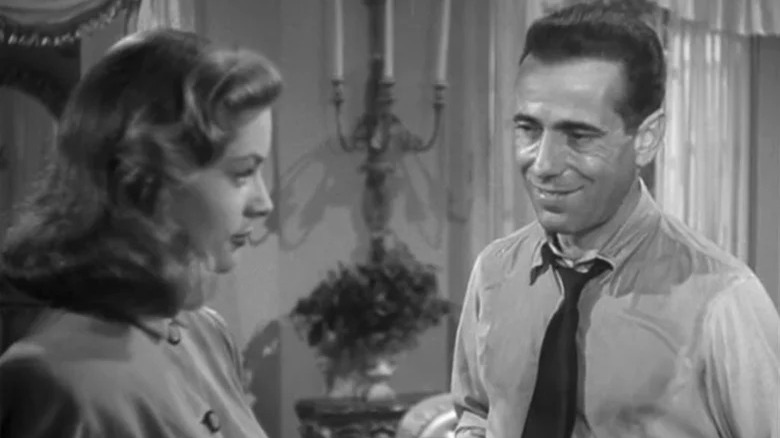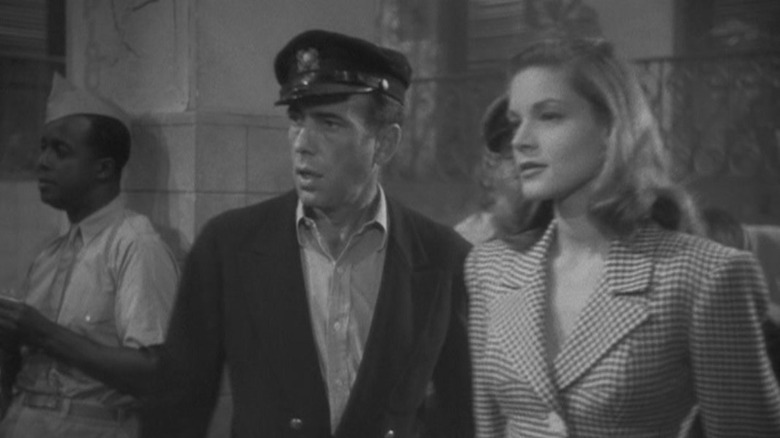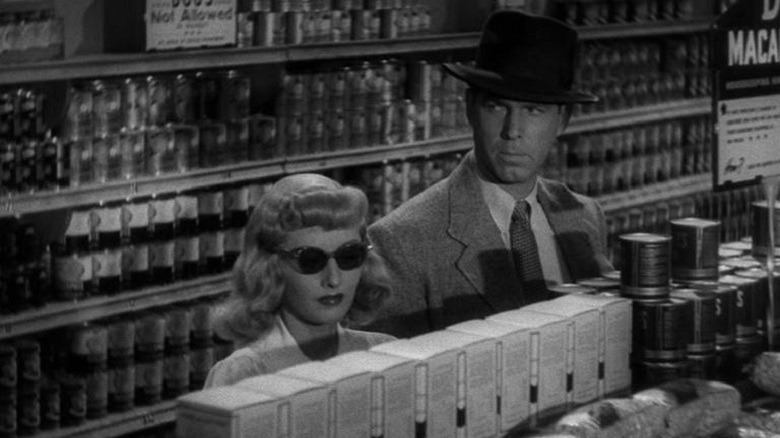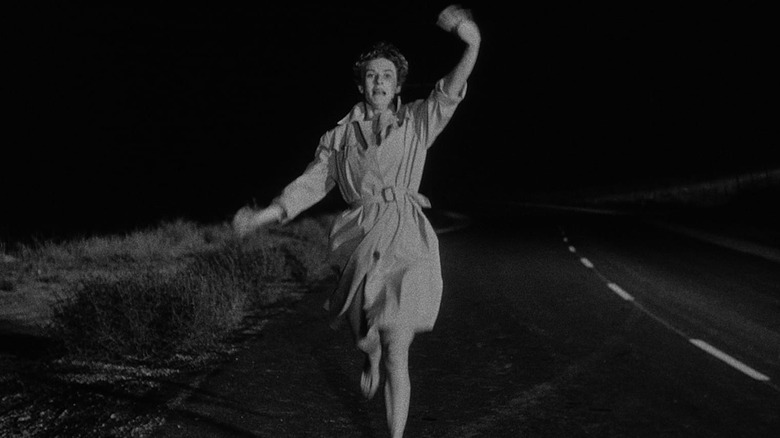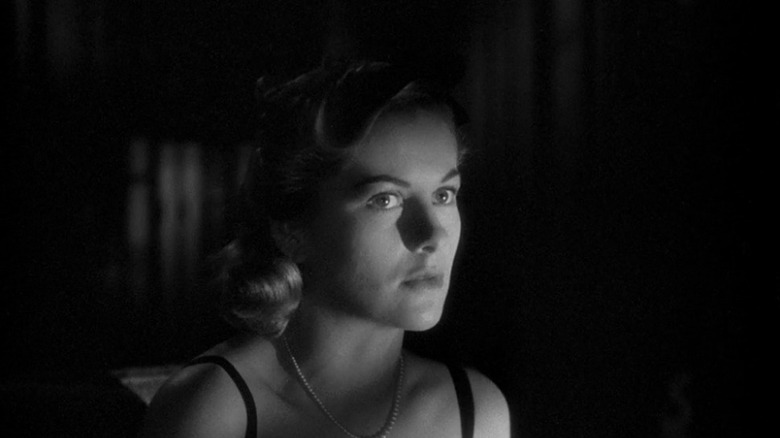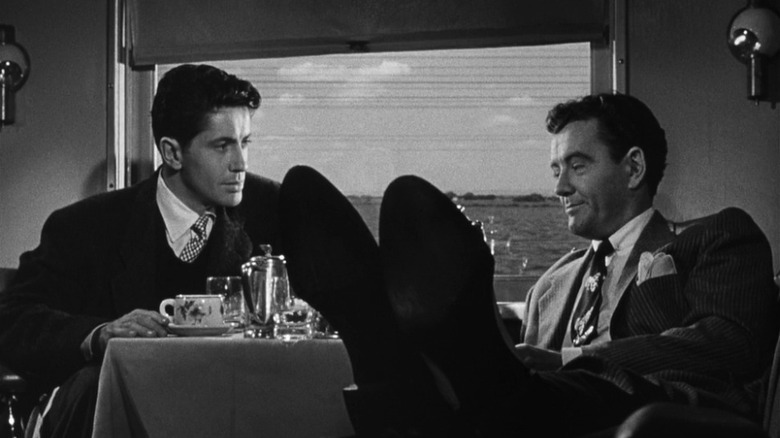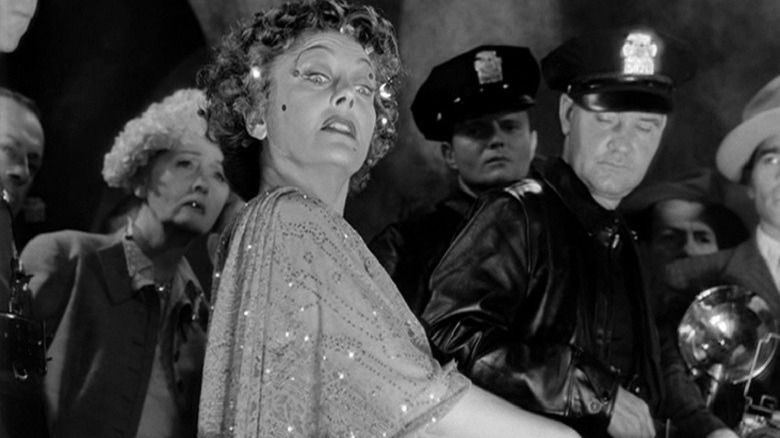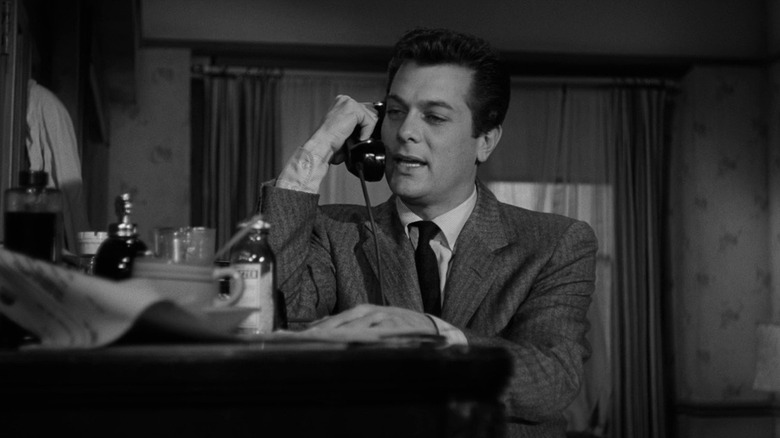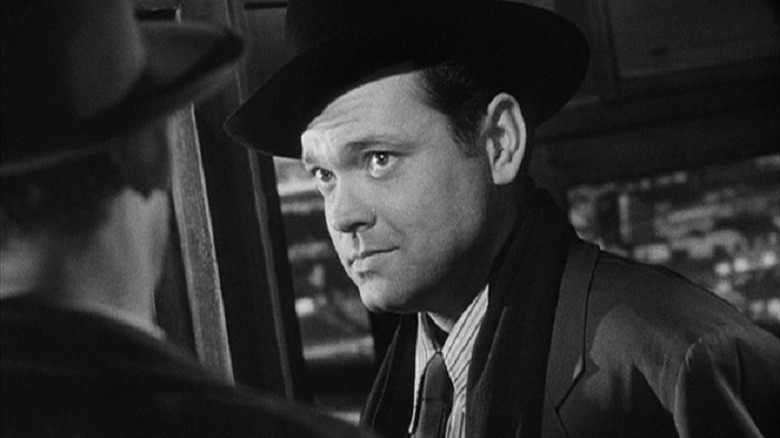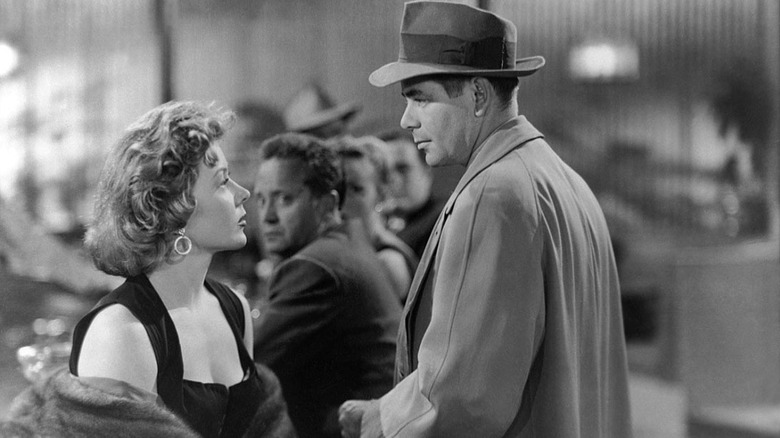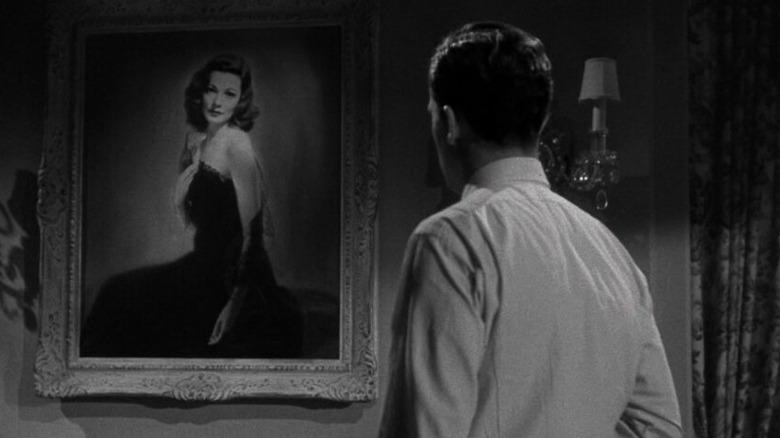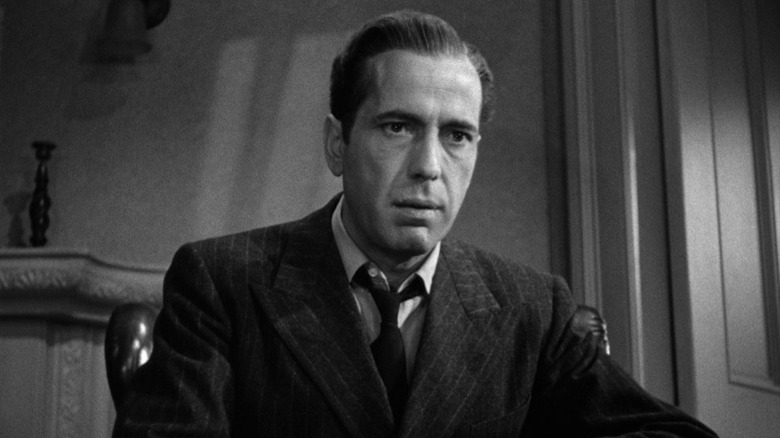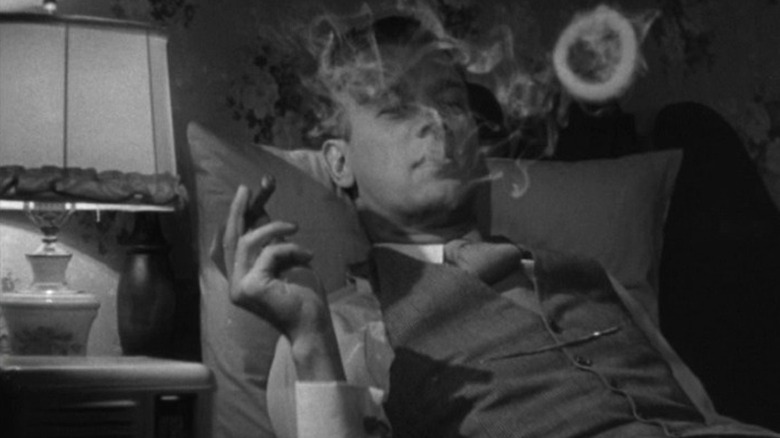20 Best Film Noir Movies Of All Time Ranked
Taken from the French phrase meaning "dark film," film noir movies are typically known for duplicitous characters, cynical protagonists, femme fatales, complex and interweaving plots, and exquisite use of light and shade. While it tends to be defined as more of a style than a genre, these types of films began to emerge in the late 1930s, and dominated the cinematic landscape in the '40s and '50s in particular.
The increasing popularity of film noir ushered in a new era and changed the way movies told their stories. Many of these films used flashback narrative devices and featured more characters that sat in the moral grey area as opposed to the clear-cut good and bad guys. In the book "Film Noir" by William Luhr, it talks of how film noir promotes an emphasis on "an individual rather than an 'objective' point of view," and that in doing this, it "shifts the viewer away from the position of moral security that earlier Hollywood films tended to offer and disconcertingly toward sympathy for the devil."
The often hard-boiled mentalities of the characters in classic film noir undoubtedly spoke to the attitude of Americans in particular who had endured a decade of struggles in the Great Depression. Through the war years, it also resonated with the feeling of paranoia and distrust against enemy spies, and those who would seek to cause divisions. It is a fascinating area of film to explore, so if you're looking for the best place to start, here are 20 of the very best film noir movies.
20. The Night of the Hunter
A shady character with ulterior motives is often a staple of film noir, and few are as malicious as preacher Harry Powell (Robert Mitchum). After he learns of the whereabouts of a large sum of money from his cellmate, Ben Harper (Peter Graves) — a man condemned to be executed — Powell charms his way into the life of his unsuspecting widow, Willa (Shelley Winters). Masquerading as a do-gooder, Powell is the last person anybody would suspect. However, he harbors disturbing, misogynistic views about women, and uses this and his religious piety to justify his deeds.
The extent of Powell's evil is particularly evident in the way he treats Willa's children, John (Billy Chapin) and Pearl (Sally Jane Bruce) — who hold the secret of where the money is. While it is common to see women emotionally manipulated by a man with ill intentions, it is less common to see children involved in the schemes, and Powell's relentless pursuit to find them gives the film an even darker edge.
As the first and only film directed by actor Charles Laughton, "The Night of the Hunter" was a critical and commercial flop (via Filmsite). However, modern reappraisal has recognized the film as a chilling and misunderstood movie, with Roger Ebert calling it, "one of the greatest of all American films." Many film noir movies are heavily influenced by German expressionism, with the use of bizarre shadows, odd angles, and the incorporation of surrealism and distortion (via ACMI). "The Night of the Hunter" uses this to its advantage, walking the finest of lines between the real world, and a twisted fairy tale.
19. Touch of Evil
While "Citizen Kane" may have been Orson Welles' masterpiece, that's no reason to sleep on the extraordinary "Touch of Evil." Directed by and starring Welles — along with an A-list cast that includes Charlton Heston, Marlene Dietrich, Janet Leigh, and Mercedes McCambridge of "The Exorcist" fame — "Touch of Evil" is a film noir that is rife with murder, kidnapping, and corruption.
Undoubtedly ahead of its time, it is an astonishingly brazen film from Welles, with the explosive opening scene effectively establishing the feeling of panic. A stunning, almost four-minute long-take, the opening follows the car of a local construction tycoon after a bomb is planted in it. Witnessed by the Mexican narcotics agent, Mike Vargas (Charlton Heston) — who is on honeymoon with his wife, Susan (Janet Leigh) — the explosion triggers a cross-borders investigation with crooked cop Hank Quinlan (Orson Welles) leading the inquiry. However, Vargas decides to follow the case closely when he realizes Quinlan may be responsible for planting evidence.
Now revered as a classic film noir, "Touch of Evil" — released 17 years after "Citizen Kane" — was a box office flop, and it prematurely ended Welles' Hollywood career when the interference from the studio left him with a film he was not satisfied with (via Box Office Mojo). In the late '90s, after Welles' death, a team of editors led by Walter Murch restored and re-cut the film, using Welles' notes as guidance and finally bringing the vision as he had intended to audiences (via Web of Stories).
18. In a Lonely Place
Screenwriter Dixon "Dix" Steele (Humphrey Bogart) hasn't had a hit in a while, and is under pressure from his agent to adapt a popular novel into a movie. Steele's life becomes like a movie, however, after he is accused of murdering hat-check girl Mildred Atkinson (Martha Stewart), who had gone to his apartment to explain the plot of the novel. When Dix's new neighbor, Laurel Gray (Gloria Grahame), is able to provide an alibi and confirms she saw Mildred leaving his apartment, the pair embark on a passionate relationship. But as Dix's zest for his work returns, Laurel begins to have doubts about her new beau.
Even though the murder happens off-screen, there is still a great deal of tension and atmosphere created, and we as the audience — like Laurel and the investigating officers — begin to question whether he could be capable of murder. A lot is unknown, and remains so to the very end. Dix evidently has a dark streak and a fiery temperature, but whether this is enough to push him to commit such a heinous act is something the film explores effectively.
With Bogart on fine form as the dark and brooding Dix Steele, "In a Lonely Place" is a gripping film with a surprising amount of depth. Through the strength of the performances and the killer script, "In a Lonely Place" is a taught film noir with an ending that will undoubtedly surprise, but perhaps not in the way that you would expect.
17. The Killing
While he may have only directed 13 feature films, Stanley Kubrick proved time and time again that he could turn his hand to any genre and create a masterpiece — whether it was horror, science fiction, or war movies (via IMDb). In "The Killing," the third feature film from Kubrick, the director proved he had the skill required to make a suspense-filled heist movie in this slick film noir crime drama.
Sterling Hayden plays Johnny Clay, an experienced veteran criminal who assembles a ragtag team to pull off a daring heist at a racetrack. With all the necessary distractions planned as cover, and the crooked law enforcement in on the job, the stage is set for one final heist before Clay gives it up for good and settles down with his girlfriend, Fay (Coleen Gray). As is often the case in heist movies, things do not go to plan, and while the details of the scam have been carefully considered, the gang fails to account for the possibility of someone else trying to double-cross them.
One of the many things Stanley Kubrick is known for as a director is his meticulous, perfectionist style, and the perfectly symmetrical shots in films such as "2001: A Space Odyssey" would become his trademark. While "The Killing" is considerably lower budget than the aforementioned sci-fi epic, the intricacy of the planned heist and the way Kubrick constructs it is demonstrative of the visual prowess he would later show.
16. Notorious
When it comes to a great film noir, it is hard to go wrong with the triple threat of Alfred Hitchcock, Ingrid Bergman, and Cary Grant in 1946's "Notorious." Grant plays government agent T.R. Devlin who recruits Alicia Huberman (Bergman) — the daughter of a German spy — for a special mission in Rio de Janeiro, and what begins as a working relationship quickly develops into a romantic one. When it is revealed that Alicia has been tasked with winning the affections of Alexander Sebastian (Claude Rains) — one of the leading members of a Nazi group hiding out in Brazil — Devlin is rendered helpless as he watches her go deep undercover.
A key theme of film noir is often a character with a chequered past, and Alicia Huberman is a fascinating example of this. Used as a pawn by Devlin and the U.S. Secret Service, Alicia has little choice but to face the past and the associates of her father, with whom she had a complicated relationship. "Notorious" explores the ideas of trust and loyalty and the dichotomy of Devlin and Sebastian towards Alicia — with Devlin taking a long time to trust her, and Sebastian perhaps being too trusting, which ends up being his undoing.
With innovative directorial flair from Hitchcock, including the impressive high-to-low tracking crane shot at Sebastian's mansion, "Notorious" is a smart and sophisticated thriller featuring a brace of excellent performances from Bergman and Grant. Where film noir movies often have complex and interweaving plot threads, "Notorious" is refreshingly straightforward, with just enough twists and turns to keep you hooked.
15. Suspicion
Many film noir movies feature a person who is not who they say they are, hiding their ill intentions behind a facade that exudes charm and trustworthiness. When it comes to casting a handsome scoundrel, few are as effective as Cary Grant, here starring as the debonair Johnnie Aysgarth who sweeps the wealthy, sheltered Lina McLaidlaw (Joan Fontaine) off her feet. While Lina is initially charmed by the man she meets on a train, he shows his true colors after they marry and she realizes he is a penniless swindler.
Directed by the Master of Suspense, Alfred Hitchcock, "Suspicion" is a slow-burning film noir that has an inescapable air of ambiguity that runs throughout. Lina seemingly doesn't want to admit her husband isn't the man she thought he was, and like her, we are kept guessing about what he may or may not have done. There are things that are spoken of — such as Johnnie's gambling addiction — but also things that are left open-ended, including whether he intended to murder his wife to claim her life insurance.
Effectively establishing a feeling of paranoia and distrust, "Suspicion" lives up to its name in the way it aligns the audience with Lina, who battles the creeping doubt about her husband while also desperately trying to believe that he couldn't possibly be capable of the things she is imagining. While the ending may seem to wrap things up too neatly, it could also be a stroke of genius, allowing our fears to be satiated just at the point where we should perhaps be most suspicious.
14. Detour
Now more commonly referred to as "B movies," films that came from outside of the main studios were known in the early years of Hollywood as "Poverty Row" movies — perhaps an unfairly disparaging term for films that lacked the same financial backing and major stars of the big studios' output. It certainly doesn't speak to the quality of "Detour," a film that utilizes every dollar of its modest budget to craft an understated and memorable film noir (via IMDb).
As well as flashbacks, a further trope of film noirs is voice narration, usually from the main character who we meet in some desolate situation, recounting the story of how they ended up there. In "Detour," the story is told by Al Roberts (Tom Neal) — a penniless former nightclub pianist — as he tries to hitchhike across the country from New York to California to be reunited with his fame-seeking girlfriend. Along the way, he meets Charles Haskell Jr. (Edmund MacDonald) — a bookie who is traveling to Los Angeles to place a bet — and after an unfortunate sequence of events, Al is forced to assume Haskell's identity to continue his journey.
With a runtime of 68 minutes, "Detour" succeeds in effectively telling its story in a short space of time, its low budget only adding to the sense of urgency and realism that permeates throughout. With a scene-stealing performance from Ann Savage as Vera, the sardonic femme fatale who decides to blackmail Al for her own gain, "Detour" is full of dark and brooding characters and a palpable sense of dread.
13. The Big Sleep
Featuring performances from two actors at the top of their game, Howard Hawks' "The Big Sleep" is a film that is much less about the plot and a lot more about the fun you'll have along the way. The film focuses on private investigator Philip Marlowe (Humphrey Bogart), who is hired by a general (Charles Waldron) to resolve the debts of his wayward daughter, Carmen (Marth Vickers). But when Carmen's sister, Vivian (Lauren Bacall), becomes involved, things take an interesting turn as bodies start piling up, and blackmail and deceit take over.
A film noir that features a mismatched pair at the center lives or dies by the chemistry between them, and fortunately, the on-screen pairing of Humphrey Bogart and Lauren Bacall — who married not long after filming finished — is enthralling from the start. Anchoring the film when things become more complex (and they really do get quite complex), the star power of the Hollywood legends is the big draw of this film that seems to take great joy in the fact it offers more questions and spiraling plot threads than it does resolution.
One of the involved and intricate film noirs, "The Big Sleep" feels like a film that epitomizes the phrase "the plot thickens," keeping things moving quicker than you can sometimes keep up with. It is still hugely enjoyable, however, and perhaps best summarized by Tim Robey's review for The Telegraph in which he said, "'The Big Sleep' is the best scripted, best directed, best acted, and least comprehensible film noir ever made."
12. To Have and Have Not
Featuring one of the all-time great onscreen (and offscreen) pairings of Humphrey Bogart and Lauren Bacall, "To Have and Have Not" marks their first appearance together in a partnership that would span a slew of successful films in the '40s. Set in Vichy, France, fishing boat captain Harry (Bogart) is reluctantly forced to switch from his position of political neutrality to fighting for the French Resistance when one of his clients is shot. Assisting hotel owner Gerard (Marcel Dalio) with smuggling fighters to the island, Harry also begins a romance with American wanderer, Slim (Lauren Bacall).
With the story involving a romance set against the backdrop of war, resistance fighters standing up to imposing forces, and the harboring of fugitives, it is clear that "To Have and Have Not" owes a certain debt to arguably one of Bogart's most famous films, 1942's "Casablanca." That being said, it is a memorable film in its own right, incorporating many stylistic and thematic elements that typify film noir movies and combining this with a slightly lighter, more romantic melodrama.
The chemistry between Lauren Bacall and Humphrey Bogart positively sizzles with an effortless quality to it that makes the central relationship feel very real. Similarly, while the film was loosely based on Ernest Hemingway's novel of the same name, and scripted by William Faulkner, many of the lines were improvised by Hawks and his talented cast, giving a further sense of authenticity (via "1001 Movies You Must See Before You Die" by Steven Jay Schneider).
11. Double Indemnity
In terms of a film that ticks all of the boxes of a classic film noir, it is hard to beat Billy Wilder's "Double Indemnity." Barbara Stanwyck takes the lead as Phyllis Dietrichson — one of the all-time great femme fatales — who uses her powers of persuasion to seduce insurance agent Walter Neff (Fred MacMurray) into murdering her husband to claim his policy. Beginning with Neff's confession to the audience — a tried and true narrative technique of film noirs — the events of the film are told in flashbacks.
Even though "Double Indemnity" begins at the end, this never hampers the film's suspenseful atmosphere, as we're still left to wonder when or if those involved might be caught. The fun of this film is in Barbara Stanwyck's unforgettable performance, using the comedic prowess she exhibited in films like 1941's "The Lady Eve," and combining it with an air of danger that easily seduces both Neff and the audience.
The smoky atmosphere created in the film is one of slowly unraveling mystery and intrigue, as initial passion paves the way for suspicion between Dietrichson and Neff, and the web closes in on their sinister plan. While there's a dark and quick wit that runs through the film, it also has an undeniably cold and ruthless streak, and a palpable tension that's completely captivating. Impeccably made, clever, and calculating, "Double Indemnity" effectively establishes the shades of grey in its characters, which is a quintessential element of film noir.
10. Kiss Me Deadly
Many film noir movies, including a great deal on this list, began life as pulpy novels. Among the multitude of books with complex and twisting narratives that proved to be the perfect fodder for films was Mickey Spillane's 1952 novel "Kiss Me Deadly," which was adapted into a film three years later. Directed by Robert Aldrich, it is a surprisingly subversive and at times brazen film noir, with a particularly distressing and horrifying ending.
The film focuses on private investigator Mike Hammer (Ralph Meeker), working in Los Angeles. After he picks up a female hitchhiker (Cloris Leachman), he becomes involved in a supernatural mystery that bears little resemblance to Spillane's novel, but is no less thrilling. Adding to the mystery, within the story itself, there is the MacGuffin of a strange box that some of the characters covet, believing it to hold a vast fortune.
While it lacks the star power of some of the other glitzier film noirs, "Kiss Me Deadly" is a surprising and wholly unique film that packs a surprising punch. It was also a film that proved to be hugely influential, with the plot device of the "mystery box" being used in films such as "Pulp Fiction." Quentin Tarantino's neo-noir crime comedy undoubtedly pays tribute to the golden era of film noir, and the director even explicitly acknowledges the influence "Kiss Me Deadly" had on his 1994 film in an interview with Sight and Sound.
9. Rebecca
Film noir can often be undefinable, and cinephiles and film academics will frequently disagree about what is and isn't classifiable film noir. Alfred Hitchcock's "Rebecca" might be a contentious inclusion for some, considering the term refers more to a style than a genre. However, the film is filled with the suspense and brooding atmosphere that so many noirs are recognized for, and it is a worthy inclusion.
In a refreshing palate cleanser to many of the hard-boiled crime-focused noirs, "Rebecca" is a lavish gothic melodrama from the Master of Suspense. Following the death of his wife, Rebecca, aristocrat Maxim de Winter (Laurence Olivier) meets a woman (Joan Fontaine) in Monte Carlo, and they marry. Eager to please her new husband, the second Mrs. de Winter finds that the spectral presence of the first Mrs. de Winter casts a shadow over the house and threatens her chance of happiness. Despite the titular woman's absence throughout the film, the power she still holds means she could be easily classifiable as a "femme fatale" — albeit a very different kind from the ones usually depicted in film noirs.
"Rebecca" notably marked Alfred Hitchcock's transition to Hollywood, and not only was it his first American film, but it was the first and only film from the Master of Suspense to win best picture at the Oscars (via IMDb). Based on the 1938 novel by Daphne du Maurier, "Rebecca" is a haunting suspense film, filled with gothic thrills and drama of the highest order.
8. Strangers on a Train
Alfred Hitchcock was no stranger to a train-based film, with locomotives forming an important part of both "The 39 Steps" and "The Lady Vanishes." Also the chosen location for the "meet-cute" between Cary Grant and Joan Fontaine in "Suspicion," there is a certain romanticism to it, with the random serendipity of who you happen to share a car with potentially having far-reaching consequences. Later becoming a very fractious partnership, this film focuses on Guy Haines (Farley Granger) and Bruno Antony (Robert Walker) as the two titular strangers who meet on the train.
After striking up a conversation, Bruno suggests that they "swap" murders — with Guy killing Bruno's estranged father and Bruno killing Guy's promiscuous wife — in order to avoid being considered as having a motive and rendering them unlikely to be suspects. Guy doesn't think Bruno is being serious, and so fails to hold up his end of the deal. But with Bruno being deadly serious — in more ways than one — things take a darker turn when he insists that Guy has to honor their deal.
"Strangers on a Train" is an intriguing film noir, with a great deal of thematic complexity underneath the deceptively simple facade. Along with Hitchcock's trademark suspense, there's a great deal of flair throughout with the use of "double" and "opposite" motifs between the two men. Hitchcock's film explores this idea of doppelgangers, and he devilishly toys with both the similarities and vast differences between the two men, inextricably linked by their dark pact.
7. Sunset Boulevard
With a gloriously unhinged performance from Gloria Swanson at the center of this film, "Sunset Boulevard" is a deliciously dark fable about fame and obsession. Told in flashback style — a common trope in film noirs — we are introduced to screenwriter Joe Gillis (William Holden), relating the events leading up to his death. Down on his luck and struggling to get his big break, Joe stumbles upon the faded former silent film star, Norma Desmond (Swanson), who dreams of making a comeback.
Living a sheltered life in her lavish Hollywood home, Gloria surrounds herself with people willing to orchestrate the fantasy that she is still as beloved as she once was — a complicated web that Joe also finds himself ensnared in — and their dangerous liaison soon takes a turn for the deadly. While Gloria is a wonderfully vampish villain, there is also a sense of sadness and complexity to her, with her desperation to be beloved once again manifesting in the elaborate, demented fantasy she creates.
The film proved to be immensely popular, with Variety reporting that it was one of the highest-grossing films of 1950. It also enjoyed awards success, winning three of the 11 Oscars it was nominated for, including best music, best art direction, and best screenplay (via IMDb). Not just one of the best film noirs, but one of the greatest films of all time, if you love movies about movies, they rarely get better than "Sunset Boulevard."
6. Sweet Smell of Success
Proving that a film noir doesn't always need to revolve around murder and violence, 1957's "Sweet Smell of Success" instead explores the power and weight of words. J.J. Hunsecker (Burt Lancaster) is a ruthless New York columnist who wields the authority to make or break a person through his highly influential newspaper. Things become personal when he tries to break up the relationship between his sister, Susan (Susan Harrison), and jazz guitarist, Steve Dallas (Martin Milner). He hires the unscrupulous press agent Sidney Falco (Tony Curtis) to initiate the smear campaign.
Positioned as a darker alternative to the peppy "His Girl Friday," "Sweet Smell of Success" looks at the cutthroat world of journalism, and the tenacity of those who would do anything to get the scoop, with little concern for the lives ruined in the process. This is a world where blackmail and corruption reign, and a man's reputation lives and dies by the words of a particularly powerful media kingpin. Sidney Falco — for all his reprehensible behavior — is a fascinating protagonist, and his desperation to be considered a "somebody" is a relatable concept.
With its jazzy soundtrack and razor-sharp script, "Sweet Smell of Success" offers a sleazy snapshot of New York City, something that would later be delved into further in Martin Scorsese's "Taxi Driver." With stars Tony Curtis and Burt Lancaster both playing against type, the film was not a box office success (via Variety). However, critics loved it, and over the years the appreciation for it has only increased, with Empire's Colin Kennedy calling it a "cast-iron classic."
5. The Third Man
In this legendarily gripping film noir, Joseph Cotten plays author Holly Martins, who arrives in a divided Vienna to see his old friend, Harry Lime (Orson Welles). However, Martins is shocked to learn his friend is dead, and becomes involved in the murder investigation to find out what happens to him. Trying to locate the witnesses, Martins learns of a mysterious "third man" who was present when Lime was killed, and sets out to uncover the identity of this missing piece of the puzzle.
Few films play with the idea of light and shade as well as "The Third Man," in both a visual sense and a narrative sense. The dynamic camera angles perfectly mimic both the twisting, turning streets of the war-ravaged Vienna, and the breathtaking revelations of the plot. The now famous score, played on the zither by Viennese musician Anton Karas, gives the film a feeling of authenticity to its setting and a unique distinctiveness. "The Third Man" is a film you won't forget, and the score is also one of the greatest in cinematic history.
The visual style of film noir is a crucial component, and "The Third Man" has style in abundance. The thrilling climax — a chase through the underground sewers — is exquisitely shot, and the way this labyrinthian location is filmed, it's clear to see what earned Robert Krasker the Oscar for cinematography (via IMDb). It is a film where all the elements combine so successfully, resulting in a film that is a tight, masterfully directed suspense thriller, and an undisputed masterpiece.
4. The Big Heat
Beginning with a gunshot and closing with a tense shootout showdown, "The Big Heat" is a stark and cynical revenge noir from director Fritz Lang. When corrupt cop Tom Duncan kills himself, homicide detective Sergeant Dave Bannion (Glenn Ford) is called in to investigate. While it may initially appear to be an open-and-shut case, the contradictory statement — and subsequent murder — of one of Duncan's mistresses indicates there is more to this case than meets the eye.
As a protagonist Bannion is particularly compelling in this film, forced into unfathomably dark places when his own family becomes a target by the crime syndicate behind the murders. Glenn Ford is perfectly cast as the everyman, balancing his sense of duty with the emerging feeling of seeking his personal vengeance. Things take a particularly interesting turn when one of the gangster's girlfriends, Debby Marsh (Gloria Grahame), becomes more involved, and she has one of the most memorable and well-earned moments of retribution in the film.
Lesser crime dramas wouldn't have as much focus on character development, but this is one of "The Big Heat's" major strengths, with even the seemingly minor players fleshed out and brought into the story in a way that feels precise and considered. Effectively establishing the sinister tone from the very beginning, "The Big Heat" is a suspenseful, masterfully directed film that sees Lang blend the familiar territory of German expressionism with the stylistic tropes of film noir.
3. Laura
In a similar vein to 1940's "Rebecca," Otto Preminger's film is notable for the conspicuous absence of the titular woman — at least initially — yet her presence is something that is felt keenly throughout. After Laura (Gene Tierney) is murdered in her apartment, Manhattan detective Mark McPherson (Dana Andrews) is assigned to the case, interrogating her friends and those closest to her — including her fiancé, Shelby Carpenter (Vincent Price), and her mentor, Waldo Lydecker (Clifton Webb).
As the investigation continues and he learns more about her through her letters and personal diary, McPherson finds he is growing dangerously obsessed with Laura (Gene Tierney), to the point of being accused of falling in love with the deceased woman by Lydecker — who is himself worryingly obsessed with her, and has a reputation for interfering in her love life through his newspaper column.
This visually lavish film noir is not only filled with suspense, but it is dazzlingly psychologically complex, giving a fresh take on the idea of obsession through McPherson's unrequited longing for Laura. The fact the film is named for her represents how key Laura is to the film — not just as the victim, but as the source of infatuation for the detective investigating her murder. Laura as the person, plus the idea of Laura and what she represents, is central to this intriguing and fascinatingly perverse film noir.
2. The Maltese Falcon
Based on the 1930 novel of the same name, and the second film adaptation of the story following the 1931 version, "The Maltese Falcon" focuses on private investigator Sam Spade (Humphrey Bogart) and his involvement in an increasingly complex case. What initially seems a cut-and-dry case to find a missing woman, soon becomes a high-stakes labyrinthine web of deceit.
Now embroiled in a complicated double murder plot following the death of his partner and the man linked to the missing woman, Sam encounters a series of eccentric adventurers — with all the overlapping roads with his case seemingly linked by one common thread: the pursuit of a rare and valuable falcon statuette. The coveted trinket may appear to be of the utmost importance, however, it is never seen. Instead, it represents the power an object can wield. The thing itself doesn't matter, but what does matter is the lengths the characters are willing to go to in order to get it.
Each new development in "The Maltese Falcon's" increasingly complex sequence of events sees an escalation in the tension, with the fast-talking script always keeping pace. While the cast members are all at the top of their game, Humphrey Bogart, as the world-wearied detective, has rarely been better than he is in this film. While "The Maltese Falcon" is a movie with no happy ending, where corruption and criminality are pervasive, it's a hugely influential piece of filmmaking, with Roger Ebert calling it "among the movies we not only love but treasure."
1. Shadow of a Doubt
It isn't uncommon for film noir movies to play on the idea of a character's duplicity, and this idea of who you can and can't trust is a feature of most of the films on this list. What elevates "Shadow of a Doubt" is the way it explores how much more sinister that idea is when the person who is not who they appear to be is a beloved family member.
While he may have played the good guy in "The Third Man," here Joseph Cotten gives an altogether more sinister performance as Charles Oakley. Idolized by his family — particularly by his niece and namesake, Charlie (Teresa Wright) — Charles arrives to see his family after his landlady tells him he was being followed at his former address. Later learning that Charles is being pursued as a possible murder suspect, Charlie is left suspicious of whether her beloved uncle is hiding a dark secret.
As with many of Hitchcock's film noir movies, the suspense comes through the shades of light and dark within the characters. In this case, it is through "Uncle Charlie," who may exude charm on the surface, yet has a stillness that suggests something more sinister. Seeing him through the adoring eyes of young Charlie when the truth is revealed is as devastating as it is surprising. The final act is a particular masterstroke — a conclusion that's both satisfying and yet deeply cynical. It isn't hard to see why "Shadow of a Doubt" is Hitchcock's personal favorite of his oeuvre, as it demonstrates so many reasons why he truly was the master of creating immaculately crafted suspense (via Brattle Film Foundation).
